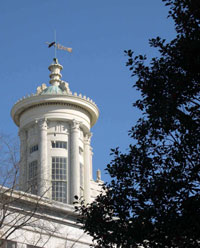Follow Their Footsteps...
So much of 18th century Philadelphia — its homes, churches and historic sites — is framed by three city blocks just south of Carpenters' Hall. Use the directions below to enjoy an hour-long stroll of Old City and Society Hill.
Use the directions below to enjoy this hour-long stroll of Old City and Society Hill
Contributionship's firemark.
Start at Carpenters' Hall. Leaving the Hall, turn left to brick wall outlining the Quaker schoolhouse Elizabeth Griscom (better known as Betsy Ross) probably attended. John Ross was the first of three husbands. Betsy's grandfather (Tobias Griscom) and father (Samuel) were Carpenters' Company members.
At 4th St, turn left to the house at the corner of Walnut St. In the second floor parlor, Aaron Burr introduced Dolley Todd, widowed in the yellow fever epidemic of 1793, to James Madison, her future husband and the fourth President.
Cross Walnut St. On 4th just beyond the garden at the corner is a walkway leading to Old St. Joseph's Church, the city's first Roman Catholic parish founded in 1733 by English Jesuit priests. Thanks to William Penn's devotion to religious freedom, a greater variety of churches flourished in Pennsylvania than in any other colony.
336 Spruce Street
Return to 4th St. Opposite is the first fire insurance company, The Philadelphia Contributionship, founded by Benjamin Franklin and others. Before issuing policies, Carpenters' Company members were hired to inspect houses for sound construction. Insurance companies placed firemarks on policyholders' homes; firemen knew who would pay for their help in case of fire. Shown here is the Contributionship's firemark.
At Locust St is the house of Dr. Caspar Wistar, physician and scientist who tutored Meriwether Lewis, President Jefferson's secretary, in preparation for the Lewis & Clark expedition.
321 4th Street
Commodore John Barry, "father of the American Navy," and other leaders of the new nation are buried at Old St. Mary's Church. British battle flags surrendered at Yorktown were placed on the altar during a mass of Thanksgiving, November 4, 1781.
At Spruce St, left to #336, built by a member of the Carpenters' Company, and birthplace of Joseph Wharton, whose fortune established the nation's first school of finance and business at the University of Pennsylvania.
338 4th Street
One block west at 427 Spruce St lived the first French consul general to the United States, followed by a commissioner of the Spanish government. Next door, at 429, lived Dorothea (Dolley) Madison and her second husband, James. A Carpenters' Company member, William Williams, built both houses in 1791.
Return to 4th St. At #321 is the Federal-style mansion of Col. Henry Hill, wealthy importer of wine from the island of Madeira. Delicately crafted, leaded glass fanlight was probably the largest in America. Pioneer surgeon Dr. Philip Syng Physick was a later owner.
Across 4th St, just beyond the walkway at #338, lived Thomas Nevell, a Carpenters' Company member who taught the first school of architecture in his home. Benedict Arnold lived for a time in the mansion Nevell built in Fairmount Park for a wealthy merchant. Nevell was among Carpenters' Company members who built Independence Hall. (Read: An Ingenious House Carpenter.)
At Pine St are two churches erected by Robert Smith, builder of Carpenters' Hall and the most famous master builder of his time. At right is Old Pine Presbyterian, used as a stable by British cavalry during the occupation. The church has been considerably altered. At left is St. Peter's Episcopal Church, little changed since colonial days. Smith carved the superb pulpit and sounding board in his shop two blocks distant, at 2nd & South Sts. (Read: A Walk with Robert Smith)
Both churches have active congregations.
At 3rd & Pine Sts. is house occupied byThaddeus Kosciuszko, an engineer from Poland who designed fortifications for Washington and was one of the first Europeans to assist the Americans.
North on 3rd St. to Delancey. Turn right to #236-38, Drinker's Court. In 1765, Henry Drinker erected his house on Pine St., then subdivided the large lot for income-producing dwellings for workingmen. Opposite are Philip and American Sts., where authentically restored colonial residences have been used for motion picture sets.
Return to 3rd St., right to #244, the showplace home of Samuel Powel, the city's last colonial mayor and the first under the new American republic. Threatened with demolition in the 1920's, the Georgian-style house was saved by Philadelphians who formed the Society for the Preservation of Landmarks.
Across the street is Old St. Paul's, another church built by Robert Smith. On the wall is a bronze plaque describing the career of Thomas Procter, a Carpenter's Company member who erected the City Tavern and was a colonel of artillery at the battles of Trenton, Princeton, Germantown and Brandywine. Follow the path beside the church to his clearly marked grave. (Read: Colonel Procter's Mission to the Indians.)
Old Pine Presbyterian
"Common Sense," a runaway best seller, had its first printing at Robert Bell's shop, just north of St. Paul's. The 46-page pamphlet challenged not only British authority but the monarchy itself. Paine, a master of everyday speech, declared what most Americans now craved — independence.
At Walnut St. is the Merchants' Exchange where ships' cargoes were bought and sold; it also housed the Philadelphia stock exchange. Now the headquarters for Independence Park. Carved lions were imported from Italy.
200-year old sculpture. Above the marble columns of the First Bank of the U.S., is a unique piece of art. Carved in solid mahogany — but painted to match the building — is the first representation of the Treasury Department seal. The Bank rented the first floor of Carpenters' Hall while its new home was under construction.










